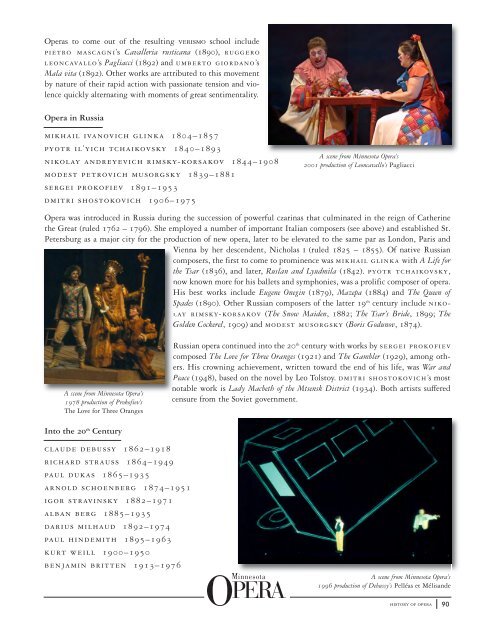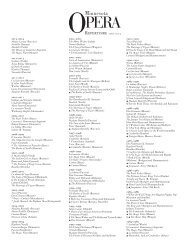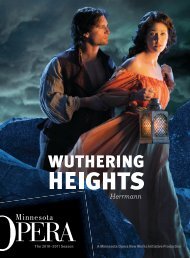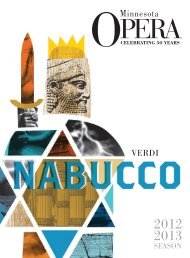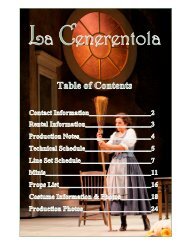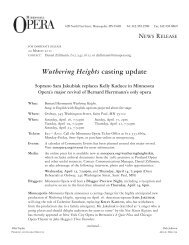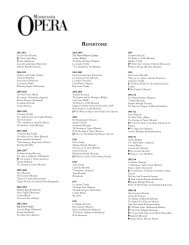Create successful ePaper yourself
Turn your PDF publications into a flip-book with our unique Google optimized e-Paper software.
<strong>Opera</strong>s to come out of the resulting verismo school include<br />
pietro mascagni’s Cavalleria rusticana (1890), ruggero<br />
leoncavallo’s Pagliacci (1892) and umberto giordano’s<br />
Mala vita (1892). Other works are attributed to this movement<br />
by nature of their rapid action with passionate tension and violence<br />
quickly alternating with moments of great sentimentality.<br />
<strong>Opera</strong> in Russia<br />
mikhail ivanovich glinka 1804–1857<br />
pyotr il’yich tchaikovsky 1840–1893<br />
nikolay andreyevich rimsky-korsakov 1844–1908<br />
modest petrovich musorgsky 1839–1881<br />
sergei prokofiev 1891–1953<br />
dmitri shostokovich 1906–1975<br />
A scene from <strong>Minnesota</strong> <strong>Opera</strong>’s<br />
2001 production of Leoncavallo’s Pagliacci<br />
<strong>Opera</strong> was introduced in Russia during the succession of powerful czarinas that culminated in the reign of Catherine<br />
the Great (ruled 1762 – 1796). She employed a number of important Italian composers (see above) and established St.<br />
Petersburg as a major city for the production of new opera, later to be elevated to the same par as London, Paris and<br />
Vienna by her descendent, Nicholas i (ruled 1825 – 1855). Of native Russian<br />
composers, the first to come to prominence was mikhail glinka with A Life for<br />
the Tsar (1836), and later, Ruslan and Lyudmila (1842). pyotr tchaikovsky,<br />
now known more for his ballets and symphonies, was a prolific composer of opera.<br />
His best works include Eugene Onegin (1879), Mazepa (1884) and The Queen of<br />
Spades (1890). Other Russian composers of the latter 19 th century include nikolay<br />
rimsky-korsakov (The Snow Maiden, 1882; The Tsar’s Bride, 1899; The<br />
Golden Cockerel, 1909) and modest musorgsky (Boris Godunov, 1874).<br />
A scene from <strong>Minnesota</strong> <strong>Opera</strong>’s<br />
1978 production of Prokofiev’s<br />
The Love for Three Oranges<br />
Russian opera continued into the 20 th century with works by sergei prokofiev<br />
composed The Love for Three Oranges (1921) and The Gambler (1929), among others.<br />
His crowning achievement, written toward the end of his life, was War and<br />
Peace (1948), based on the novel by Leo Tolstoy. dmitri shostokovich’s most<br />
notable work is Lady Macbeth of the Mtsensk District (1934). Both artists suffered<br />
censure from the Soviet government.<br />
Into the 20 th Century<br />
claude debussy 1862–1918<br />
richard strauss 1864–1949<br />
paul dukas 1865–1935<br />
arnold schoenberg 1874–1951<br />
igor stravinsky 1882–1971<br />
alban berg 1885–1935<br />
darius milhaud 1892–1974<br />
paul hindemith 1895–1963<br />
kurt weill 1900–1950<br />
benjamin britten 1913–1976<br />
A scene from <strong>Minnesota</strong> <strong>Opera</strong>’s<br />
1996 production of Debussy’s Pelléas et Mélisande<br />
history of opera<br />
90


